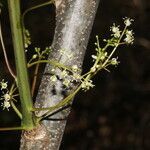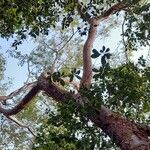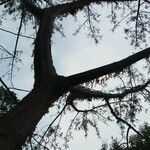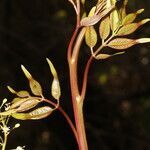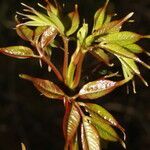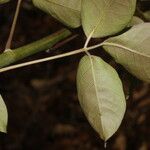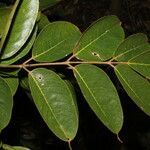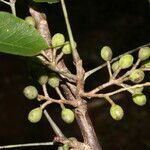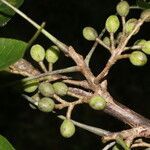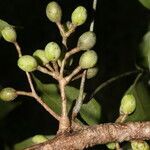ish-woolly, becoming reddish-brown, covered with yellowish lenticels and con-spicuously marked by large elevated cordate leaf scars. Leaves odd-pinnate, 21-35 cm long and 12-23.5 cm wide; petioles puberulent basally and sparingly pubescent above, or glabrous to rarely yellowish-woolly, 7-11.5 cm long; leaf-lets 5-7(-9), long-acuminate, inequilateral basally, the laterals broadly ovate to ovate-oblong, the terminals obovate, membranaceous to coriaceous, the margins entire, conspicuously lanate when young to nearly glabrate in age, becoming sparingly pubescent above, at least the veins pubescent beneath, slightly shiny above, paler beneath, the blades 4.5-14.5 cm long and 2.5-8 cm wide; petiolules pubescent to glabrous, 5-31 mm long; rachis not winged. Inflorescences usually glabrous, reddish; staminate 17-28 cm long, longer than the young leaves; car-pellate 4-10.5 cm long, ca. as long as the young leaves. Flowers 3-or 5-merous, with glabrous pedicels 2-4 mm long in flower and 5-16 mm long in fruit; staminate 5-merous, the calyx shallowly 5-lobed, the lobes less than 1 mm long, the petals 5, ovate-elliptic, acute and incurved apically, 2-2.5 mm long and 1 mm wide, the stamens 10, ca. as long as the petals, the filaments 1.5 mm long, the disc 5-lobed; carpellate 3-merous, the calyx lobes 3, the petals 3, ovate, acute and incurved apically, 2 mm long and ca. 1 mm wide, the stamens 6, ca. half as long as the petals, the ovary 3-loculed, ovoid, ca. 2 mm high, the stigma 3-lobed. Fruits subglobular, pointed at both ends, slightly 3-angled, green to bright pink, maturing reddish-brown and drying brownish, 8-13 mm long and 7-9 mm in diameter, dehiscing by 3 obovate valves; pyrenes 1(-2), 1-seeded, 3-angled, bony, lenticular-ovoid, pinkish to whitish, attached to the pedicel by a persistent whitish column ca. 2 mm long.
More
A deciduous tree. It grows up to 18-25 m tall. It has a single trunk and deep taproot. The trunk is smooth and red. The wood is spongy and has resin. The limbs are thick and covered with a rusty red skin. This peels off in thin sheets. The leaves have leaflets along the stalk and are bright green. The leaflets are about 8 cm long. The flowers are creamy white and fairly showy. They are held in thin spreading panicles. The fruit are succulent red berries. They are 1.3 cm across. They are in clusters. The fruit are 3 angled. They are edible.
Trees, 5-20 m high; bark coppery-red, shiny, thin, peeling off in thin papery sheets to expose a smooth bright-green layer; branchlets glabrous to rarely yellow-
